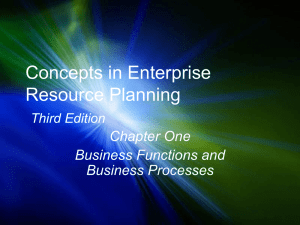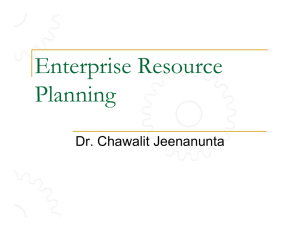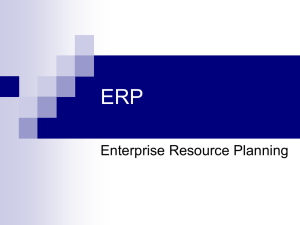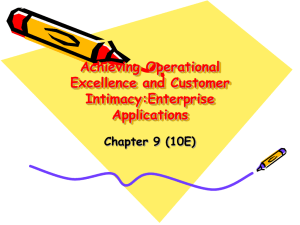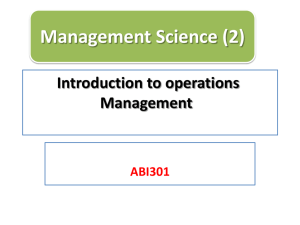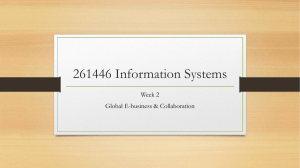business process
advertisement
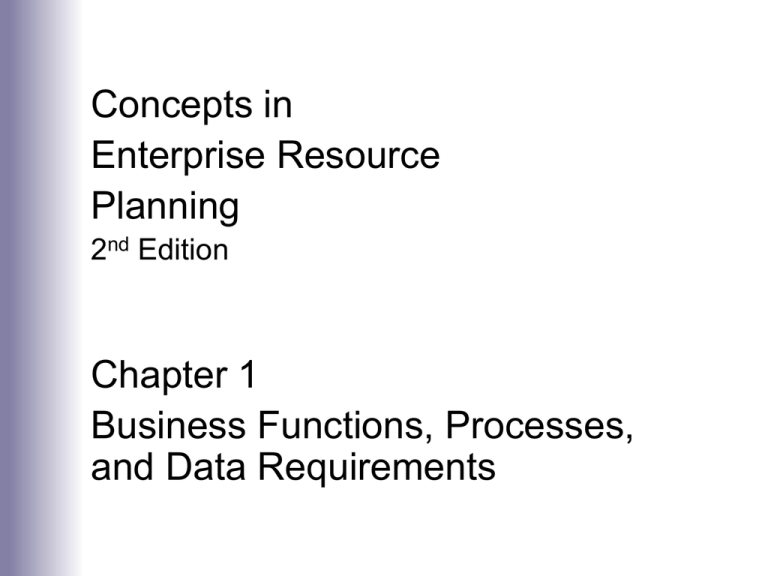
Concepts in Enterprise Resource Planning 2nd Edition Chapter 1 Business Functions, Processes, and Data Requirements Chapter Objectives • Name a business's main areas of operation. • Differentiate a business process from a business function. • Identify the kinds of data that each main functional area produces. • Identify the kinds of data that each main functional area needs. • Define integrated information systems and state why they are important Concepts in Enterprise Resource Planning, Second Edition 2 ERP Overview • Enterprise Resource Planning (ERP) programs are software used by companies to manage information in every area of the business. • ERP programs help manage company-wide business processes using a common database and shared management reporting tools. • ERP software supports the efficient operation of business processes by integrating activities throughout a business. Concepts in Enterprise Resource Planning, Second Edition 3 Functional Areas of Operation • Most companies have four main functional areas: • Marketing and Sales (M/S) • Supply Chain Management (SCM) • Accounting and Finance (A/F) • Human Resources (HR) • Historically, businesses have organized themselves according to business functions. • Business Schools continue to be similarly organized. Concepts in Enterprise Resource Planning, Second Edition 4 Functional Areas of Operation Concepts in Enterprise Resource Planning, Second Edition 5 Information System • An information system includes the: • Computers • People • Procedures • Software • Required to store, organize and deliver information • Information systems are a critical tool for integrating business functions • The better a company can integrate the activities of each functional area, the more successful it will be in today’s highly competitive environment. Concepts in Enterprise Resource Planning, Second Edition 6 Business Processes • A business process is a collection of activities that takes one or more inputs and creates an output that is of value to the customer, for example • Input – Technical support by M/S • Process – 24-hour help line available • Output – Customer’s technical query is resolved • The customer may be the traditional external customer who buys the product or service, or an internal customer (a colleague in another department) • The customer does not care that different functions are involved in processing their order, and will not tolerate mistakes and delays caused by poor coordination of business functions Concepts in Enterprise Resource Planning, Second Edition 7 Sample of Business Processes • Suppose that a customer wants to purchase a new computer. • She wants information about the company’s products. • She wants to place her order quickly and easily. • She expects quick delivery of a correctly configured, working computer. • She wants 24-hour customer support for any problems. • The customer is not concerned about how the computer was marketed, or how its components were purchased, or how it was built, or the route the delivery truck took to get to her house. Concepts in Enterprise Resource Planning, Second Edition 8 Sample of Business Processes • Suppose the customer’s computer is damaged during shipment. • Several functional area (i.e. CRM, M/S) are involved in repair and return of the computer, the handling of the repair is a business process. • A successful customer interaction is one in which the customer is not required to interact with each business function involved in the process. Concepts in Enterprise Resource Planning, Second Edition 9 • Successful business managers view their business operations from the perspective of a satisfied customer. • For the computer company to provide customer satisfaction, it must take sure that its functional areas of operation are integrated. For example • Computer technology changes rapidly, and the hardware the company sells changes frequently. Therefore, people performing the sales function must have up-to-date information about computer configurations so they can provide the customer with accurate information. • People performing the manufacturing function need to get the details of the customer’s computer configuration quickly and accurately from those performing the sales function, so the right computer can be manufactured and shipped on time to the customer. Concepts in Enterprise Resource Planning, Second Edition 10 Process View of Business Logistics Function Production Function Purchasing Function Accounting Function Sales Function Customer Order Process Material Order Process Figure 1-3 A process view of business Concepts in Enterprise Resource Planning, Second Edition 11 • Business take inputs in the form of material, people, and equipment and transform these inputs into goods and services for the customer. • Managing these inputs and the business processes effectively requires accurate and up-to-date information. • For example, the sales function takes a customer’s order, and the product’s manufacture is scheduled by the production function. • Logistics employees schedule and carry out the product’s delivery. • If raw materials are needed to make the product, production would prompt purchasing to arrange for their purchase and delivery. • In that case, logistics would receive the material, verify its condition to accounting so that the vendor could be paid, and deliver the goods to production. Throughout, accounting would keep appropriate transaction records. Concepts in Enterprise Resource Planning, Second Edition 12 Integration of Business Functions • Sharing data efficiently and effectively within and between functional areas leads to more efficient business processes • Information systems that share data between functional areas are called Integrated Information Systems Concepts in Enterprise Resource Planning, Second Edition 13 Lemonade Stand Functional Areas 1. Marketing and Sales • Develop products • Determine pricing • Promote products • Take customer orders • Make sales forecast • Track repeat customers to send flyers or thank-you notes • Manage credit Concepts in Enterprise Resource Planning, Second Edition 14 Lemonade Stand Functional Areas 2. Supply Chain Management • Buying raw materials (purchasing) • Making lemonade (production) • Manage recipe • Maintain manufacturing (cost) records Concepts in Enterprise Resource Planning, Second Edition 15 Lemonade Stand Functional Areas 3. Accounting and Finance • Recording raw transaction data • Sales, raw material purchases, payroll, cash receipts • Provide data for sales forecasting, credit management, cash management Concepts in Enterprise Resource Planning, Second Edition 16 Lemonade Stand Functional Areas 4. Human Resources • Recruit, train, evaluate and compensate employees • Develop personnel plans (staffing) based on sales • Determine compensation/wages—depends on labor market Concepts in Enterprise Resource Planning, Second Edition 17 Functional Area Information Systems Concepts in Enterprise Resource Planning, Second Edition 18 Marketing and Sales • Inputs • Customer data • Order data • Sales trend data • Per-unit cost • Outputs • Sales strategies • Product pricing Concepts in Enterprise Resource Planning, Second Edition 19 Marketing and Sales 1. Customers communicate their orders to M/S by telephone, e-mail, fax, the Web, etc. 2. Sales orders must be passed to SCM for planning purposes and to A/F for billing. 3. Sales order data can be used to analyze sales trends for business decision making. • To evaluate marketing efforts and • To determine strategies for the sales force. 4. M/S also has a role in determining product prices, which requires and understanding of the market competition and the costs of manufacturing the product. 5. Determining the cost of manufacturing a product requires information from A/F which, in turn, relies on SCM data. Concepts in Enterprise Resource Planning, Second Edition 20 Functional Area Information Systems Concepts in Enterprise Resource Planning, Second Edition 21 Supply Chain Management • Inputs • Product sales data • Production plans • Inventory levels • Outputs • Raw material orders • Packaging orders • Resource expenditure data • Production and inventory reports Concepts in Enterprise Resource Planning, Second Edition 22 Supply Chain Management 1. Manufacturing firms develop production plans of varying length and detail. For example • expanding manufacturing capacity, • hiring new workers, • paying extra overtime for existing workers and • taking sales forecasts to plan manufacturing runs. 2. Production plans are based on information about product sales that comes from M/S. 3. The purchasing function bases its orders of raw materials on production plans, expected shipments, delivery lead time, and existing inventory levels. 4. With accurate data about required production levels, raw material and packaging can be ordered as needed, and inventory levels can be kept low, saving money. Concepts in Enterprise Resource Planning, Second Edition 23 Supply Chain Management (cont.) 5. SCM records can provide the data needed by A/F to determine how much of each resource: • • • • materials labor supplies overhead was spent to make completed products in inventory. 6. SCM data can support the M/S function by providing information about what has been produced and shipped. 7. Accurate and timely production information can support the sales production and increase customer satisfaction. Concepts in Enterprise Resource Planning, Second Edition 24 Functional Area Information Systems Concepts in Enterprise Resource Planning, Second Edition 25 Accounting and Finance • Inputs • Payments from customers • Accounts receivables data • Accounts payables data • Sales data • Production and inventory data • Payroll and expense data • Outputs • Payments to suppliers • Financial reports • Customer credit data Concepts in Enterprise Resource Planning, Second Edition 26 Accounting and Finance 1. A/F personnel record the company’s transactions in the books of account. For example, • • they record accounts receivable when sales are made and cash receipts when customers send in payments; and they record account payable when raw materials are purchased and cash outflows when they pay for materials. 2. People in other functional areas provide data to A/F: • • • M/S provides sales data SCM provides production and inventory data, and HR provides payroll and benefit expense data. 3. M/S personnel require data from A/F to evaluate customer credit. • If an order will cause the customer to exceed his credit limit, M/S should see that the customer’s accounts receivable balance is too high and hold new orders. Concepts in Enterprise Resource Planning, Second Edition 27 Functional Area Information Systems Concepts in Enterprise Resource Planning, Second Edition 28 Human Resources • Inputs • Personnel forecasts • Skills data • Outputs • Regulation compliance • Employee training and certification • Skills database Concepts in Enterprise Resource Planning, Second Edition 29 Human Resources 1. Tasks related to employee hiring, benefits, training, and government compliance are all the responsibilities of a human resource department. 2. HR needs to know what skills are needed to perform a particular job and how much the company can afford to pay employees. 3. HR’s responsibilities to ensure that employees receive training in a timely manner. 4. HR also must ensure that employee get certified in key skills, such as material handling and equipment operation. 5. Employee must be paid, and they must be considered for raises and bonuses. Concepts in Enterprise Resource Planning, Second Edition 30 Summary • All manufacturing companies have basic functional areas of: • Marketing and Sales: Sets product prices, promotes products, takes customer orders, and creates sales forecasts. • Supply Chain Management: Develops production plans, orders raw materials from suppliers, receives the raw material into the facility, manufactures products, and ships products to customers. Concepts in Enterprise Resource Planning, Second Edition 31 Summary • All manufacturing companies have basic functional areas of: • Accounting and Finance: Records sales transactions, records customers’ payments, records suppliers’ invoices and payments to suppliers, and summarizes operational data in managerial reports. • Human Resources: Recruits, trains, compensates, and oversees the evaluation of employees. Concepts in Enterprise Resource Planning, Second Edition 32 Summary • Functional areas are served by information systems, which capture, process, and store data to provide information needed for decision making. Concepts in Enterprise Resource Planning, Second Edition 33 Summary • Employees working in one functional area need data from other functional areas. Functional area information systems should be integrated, so shared data are accurate and readily available. Concepts in Enterprise Resource Planning, Second Edition 34 Summary • Business managers are increasingly thinking in terms of business processes that integrate functional areas. • The business process view promotes efficiency and competitiveness. • Business processes require information sharing between functional areas. • ERP software provides this capability by using a single common database. Concepts in Enterprise Resource Planning, Second Edition 35
